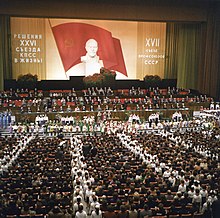One-party state
An one-party system is a form of government where the country is ruled by a single political party, meaning only one political party exists and the forming of other political parties is forbidden.[1][2]

Some countries have many political parties that exist, but only one that can by law be in control. This is called a one-party dominant state. In this case opposition parties against the dominant ruling party are allowed, but have no real chance of gaining power. For example, in China all power is vested in the Communist Party of China. Other parties are allowed to exist only if they accept the leading role of the Communist Party[1] .[2]
Tukey under the Committee of Union and Progress is sometimes called the first one-party state. The Soviet Union from 1922–1991, Nazi Germany from 1933–1945, Italy under Benito Mussolini from 1922–1943, and various Eastern Bloc states are some of the best-known examples of one-party states in history. Some one-party states are considered dictatorships and called a police state or a military dictatorship, if a secret police force or the military is used to keep a dictator in power through force.
The one-party system is also a common trait of communist Marxist-Leninist and fascist political philosophies.
Examples change
As of October 1, 2020, there are 8 states that are ruled by a single party:
- China (Communist party of China, 8 registered minor parties)
- Democratic People's Republic of Korea (AKA- North Korea) (Korean Workers' Party) - 2 minor parties that exist on paper only
- Vietnam (Vietnamese Communist party)
- Cuba (Cuban Communist party)
- Eritrea
- Sahrawi Arab Democratic Republic
- Myanmar (Burma) A military dictatorship removed the elected president and now rules the country. There are no elections. Htin Kyaw was appointed Prime Minister by the Army.
- Laos (Communist party of Laos)
Former examples of one-party states change
Those are states whose were formerly ruled by single parties:
- Nazi Germany (Nazi Party)
- Kingdom of Italy (National Fascist Party)
- Socialist Republic of Romania (Romanian Communist Party)
- Democratic Kampuchea (Communist Party of Kampuchea)
- Empire of Japan (Imperial Rule Assistance Association)
- Polish People's Republic (Polish Workers' Party)
- Soviet Union (Communist Party of the Soviet Union)
- Socialist Federal Republic of Yugoslavia (League of Communists of Yugoslavia)
- Syrian Arab Republic (Ba'ath Party)[3]
- Serbia (Serbian Progressive Party)
Similar situations change
De facto one-party states change
Countries where other parties are legal, but none exists at present. Also, in some kingdoms a royal family actually rules the country with or without political parties. Kingdoms and Emirates in the Middle East are examples.
Dominant-party system change
Examples commonly cited include: United Russia (CP) in Russia, the New Azerbaijan Party in Azerbaijan, the Justice and Development Party (AKP) in Turkey, Serbian Progressive Party (SNS) in Serbia, Democratic Party of Socialists of Montenegro (DPS) in Montenegro, the People's Action Party (PAP) in Singapore, the African National Congress (ANC) in South Africa, the Ba'ath Party in the Syrian Arab Republic, Democratic Party of Equatorial Guinea in Equatorial Guinea, Awami League in Bangladesh, the Belaya Rus in Belarus, PSUV in Venezuela, MPLA in Angola, the FRELIMO in Mozambique, the Colorado Party in Paraguay, the ZANU-PF in Zimbabwe,[4] and the Liberal Democratic Party in Japan.
In some countries which have this system, methods are used to suppress other parties, without actually banning them. In some cases state power is used directly and indirectly to prevent smaller parties getting more votes. This can include electoral fraud, gerrymandering or court decisions (which are controlled by the government). In many cases, opposition leaders and other figures are prevented from using the mass media at election time, and also they often are threatened, harassed, jailed and even killed. In other cases, apart from the government candidates, only candidates from smaller allied parties and "independent" candidates who are closely allied to the dominant ruling party, get an overwhelming advantage.
In these cases, the defeat of the government "cannot be expected for the forseeable future".[4]
References change
- ↑ 1.0 1.1 "Single-party state".
- ↑ 2.0 2.1 "Single-party state".
- ↑ "Political parties - Syria - power, sector". www.nationsencyclopedia.com. Retrieved 2020-09-16.
- ↑ 4.0 4.1 Suttner R. 2006 Party dominance 'theory': of what value?", Politikon 33 (3), pp. 277-297.